ACC00153 Southern Cross University: Internal Controls Analysis
VerifiedAdded on 2024/04/25
|11
|2148
|241
Essay
AI Summary
This essay provides a comprehensive analysis of internal control systems, the control environment, and organizational objectives within a business context. It addresses the relationship between these elements, explaining how a robust internal control system and a positive control environment contribute to achieving organizational goals. The essay also classifies various control activities as either general or application controls, providing detailed explanations for each classification. Furthermore, it identifies potential risks in a business process, suggests internal controls to mitigate these risks, and classifies these controls based on their presence, type (general or application), and method (manual or computerized). This document is available on Desklib, where students can find a wealth of resources, including past papers and solved assignments, to aid in their studies.
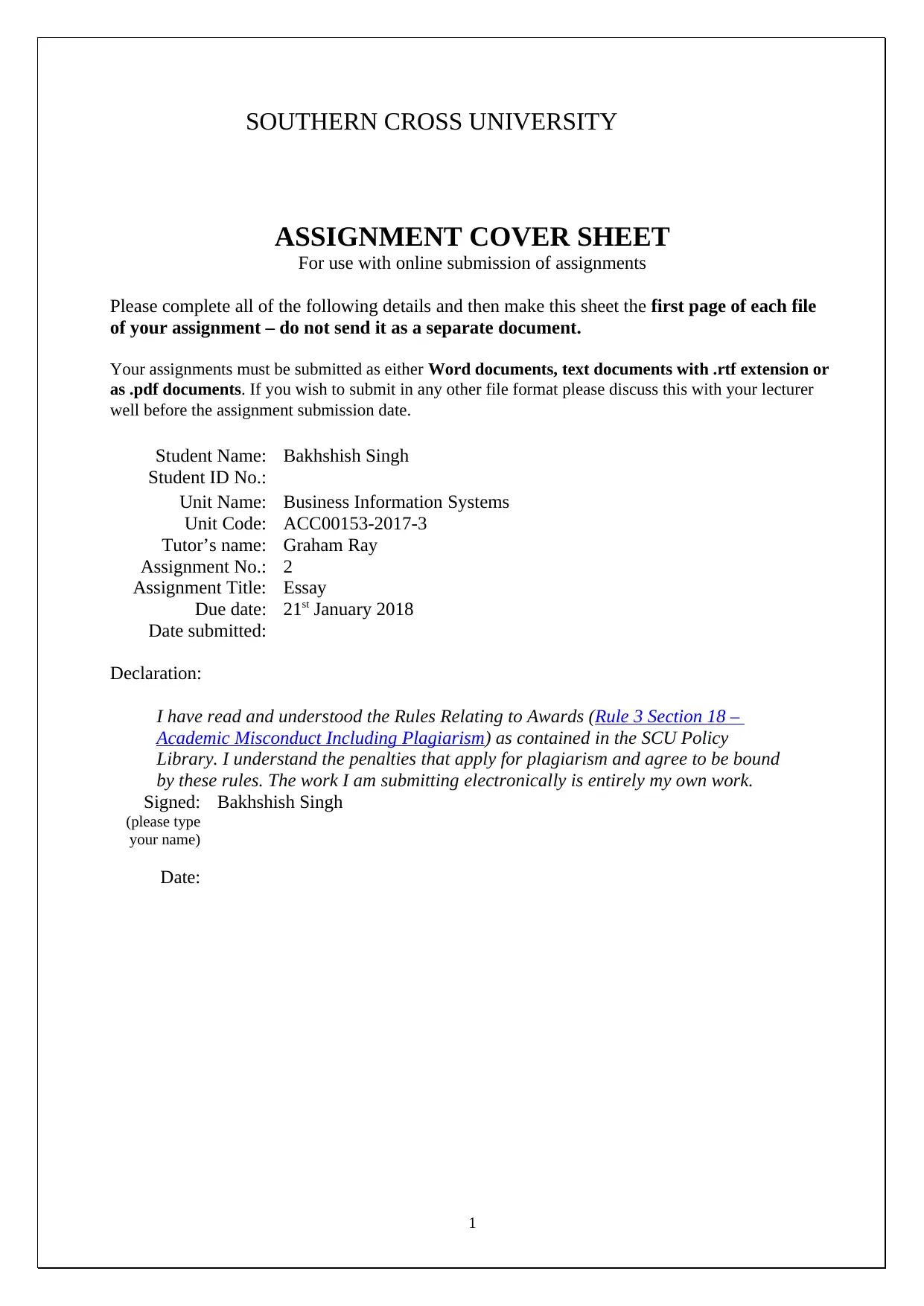
SOUTHERN CROSS UNIVERSITY
ASSIGNMENT COVER SHEET
For use with online submission of assignments
Please complete all of the following details and then make this sheet the first page of each file
of your assignment – do not send it as a separate document.
Your assignments must be submitted as either Word documents, text documents with .rtf extension or
as .pdf documents. If you wish to submit in any other file format please discuss this with your lecturer
well before the assignment submission date.
Student Name: Bakhshish Singh
Student ID No.:
Unit Name: Business Information Systems
Unit Code: ACC00153-2017-3
Tutor’s name: Graham Ray
Assignment No.: 2
Assignment Title: Essay
Due date: 21st January 2018
Date submitted:
Declaration:
I have read and understood the Rules Relating to Awards (Rule 3 Section 18 –
Academic Misconduct Including Plagiarism) as contained in the SCU Policy
Library. I understand the penalties that apply for plagiarism and agree to be bound
by these rules. The work I am submitting electronically is entirely my own work.
Signed:
(please type
your name)
Bakhshish Singh
Date:
1
ASSIGNMENT COVER SHEET
For use with online submission of assignments
Please complete all of the following details and then make this sheet the first page of each file
of your assignment – do not send it as a separate document.
Your assignments must be submitted as either Word documents, text documents with .rtf extension or
as .pdf documents. If you wish to submit in any other file format please discuss this with your lecturer
well before the assignment submission date.
Student Name: Bakhshish Singh
Student ID No.:
Unit Name: Business Information Systems
Unit Code: ACC00153-2017-3
Tutor’s name: Graham Ray
Assignment No.: 2
Assignment Title: Essay
Due date: 21st January 2018
Date submitted:
Declaration:
I have read and understood the Rules Relating to Awards (Rule 3 Section 18 –
Academic Misconduct Including Plagiarism) as contained in the SCU Policy
Library. I understand the penalties that apply for plagiarism and agree to be bound
by these rules. The work I am submitting electronically is entirely my own work.
Signed:
(please type
your name)
Bakhshish Singh
Date:
1
Paraphrase This Document
Need a fresh take? Get an instant paraphrase of this document with our AI Paraphraser
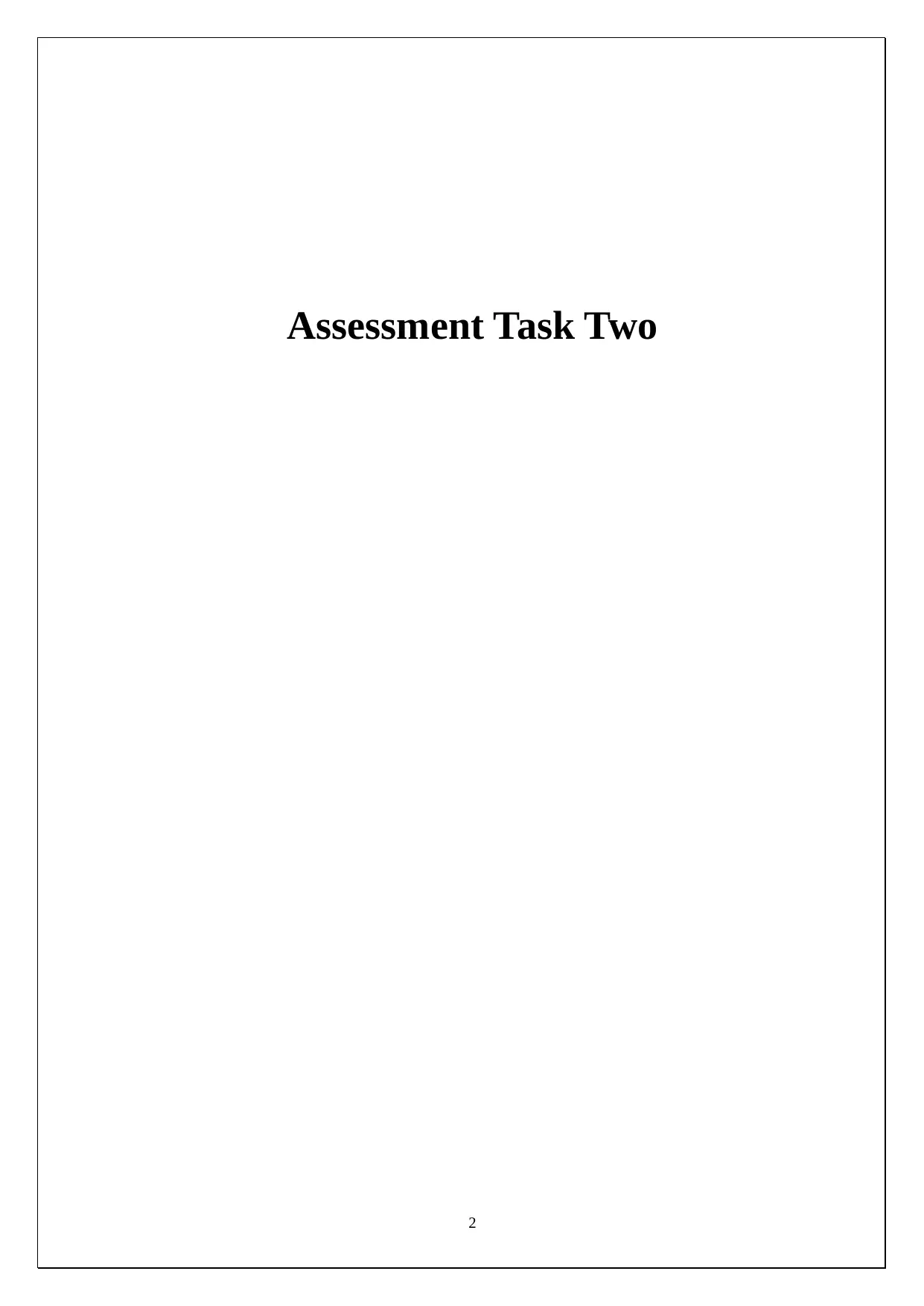
Assessment Task Two
2
2
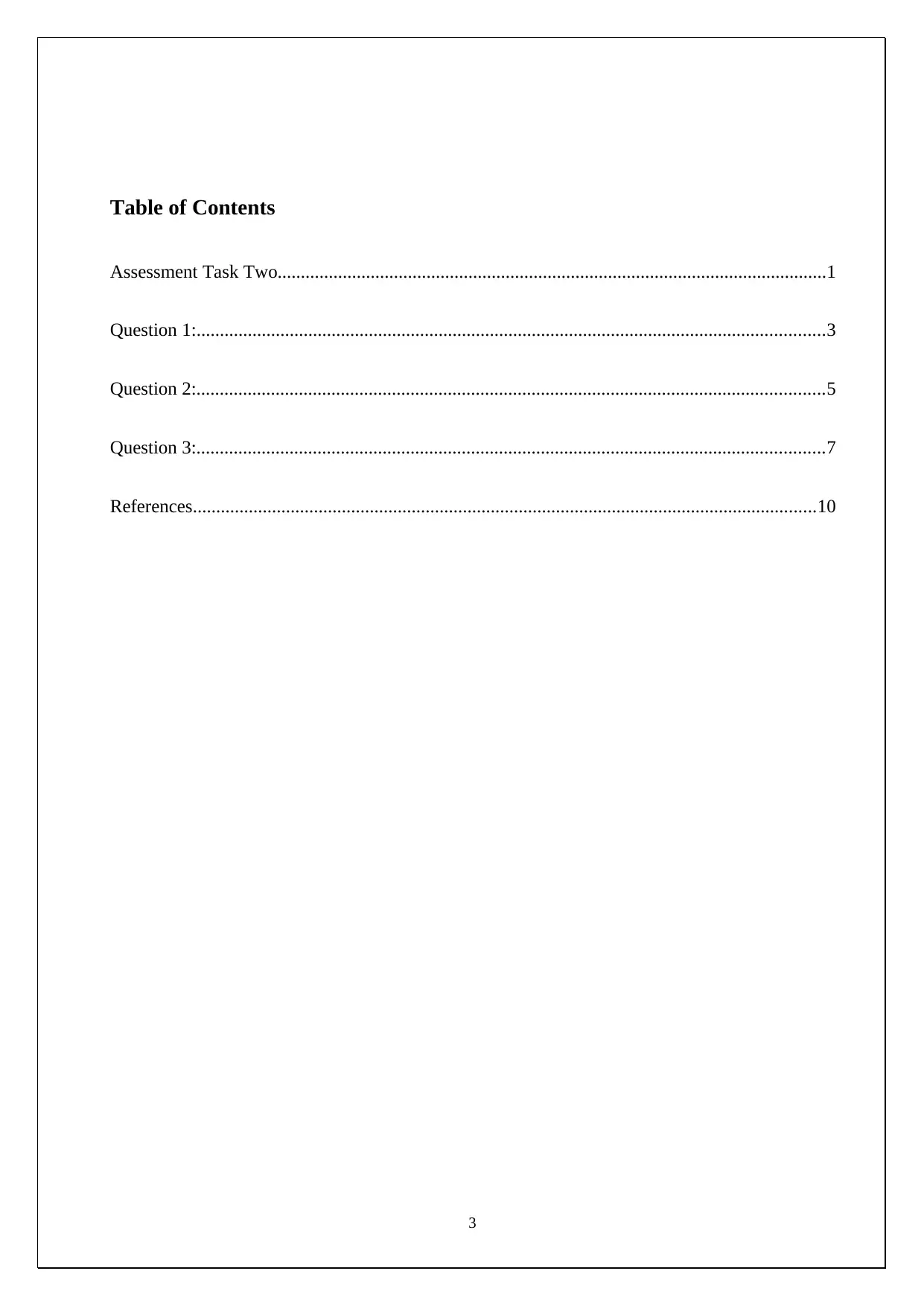
Table of Contents
Assessment Task Two......................................................................................................................1
Question 1:.......................................................................................................................................3
Question 2:.......................................................................................................................................5
Question 3:.......................................................................................................................................7
References......................................................................................................................................10
3
Assessment Task Two......................................................................................................................1
Question 1:.......................................................................................................................................3
Question 2:.......................................................................................................................................5
Question 3:.......................................................................................................................................7
References......................................................................................................................................10
3
⊘ This is a preview!⊘
Do you want full access?
Subscribe today to unlock all pages.

Trusted by 1+ million students worldwide
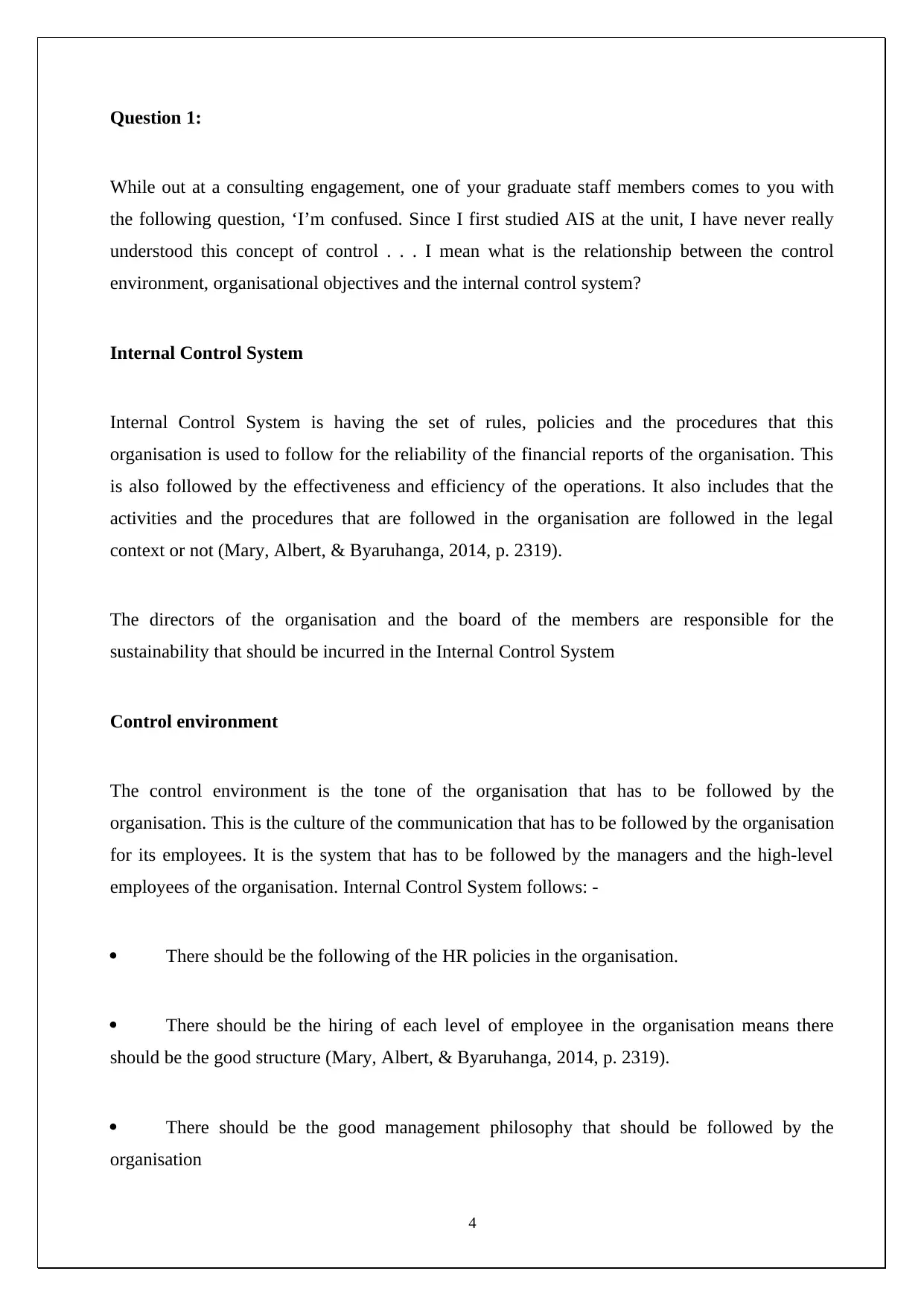
Question 1:
While out at a consulting engagement, one of your graduate staff members comes to you with
the following question, ‘I’m confused. Since I first studied AIS at the unit, I have never really
understood this concept of control . . . I mean what is the relationship between the control
environment, organisational objectives and the internal control system?
Internal Control System
Internal Control System is having the set of rules, policies and the procedures that this
organisation is used to follow for the reliability of the financial reports of the organisation. This
is also followed by the effectiveness and efficiency of the operations. It also includes that the
activities and the procedures that are followed in the organisation are followed in the legal
context or not (Mary, Albert, & Byaruhanga, 2014, p. 2319).
The directors of the organisation and the board of the members are responsible for the
sustainability that should be incurred in the Internal Control System
Control environment
The control environment is the tone of the organisation that has to be followed by the
organisation. This is the culture of the communication that has to be followed by the organisation
for its employees. It is the system that has to be followed by the managers and the high-level
employees of the organisation. Internal Control System follows: -
There should be the following of the HR policies in the organisation.
There should be the hiring of each level of employee in the organisation means there
should be the good structure (Mary, Albert, & Byaruhanga, 2014, p. 2319).
There should be the good management philosophy that should be followed by the
organisation
4
While out at a consulting engagement, one of your graduate staff members comes to you with
the following question, ‘I’m confused. Since I first studied AIS at the unit, I have never really
understood this concept of control . . . I mean what is the relationship between the control
environment, organisational objectives and the internal control system?
Internal Control System
Internal Control System is having the set of rules, policies and the procedures that this
organisation is used to follow for the reliability of the financial reports of the organisation. This
is also followed by the effectiveness and efficiency of the operations. It also includes that the
activities and the procedures that are followed in the organisation are followed in the legal
context or not (Mary, Albert, & Byaruhanga, 2014, p. 2319).
The directors of the organisation and the board of the members are responsible for the
sustainability that should be incurred in the Internal Control System
Control environment
The control environment is the tone of the organisation that has to be followed by the
organisation. This is the culture of the communication that has to be followed by the organisation
for its employees. It is the system that has to be followed by the managers and the high-level
employees of the organisation. Internal Control System follows: -
There should be the following of the HR policies in the organisation.
There should be the hiring of each level of employee in the organisation means there
should be the good structure (Mary, Albert, & Byaruhanga, 2014, p. 2319).
There should be the good management philosophy that should be followed by the
organisation
4
Paraphrase This Document
Need a fresh take? Get an instant paraphrase of this document with our AI Paraphraser
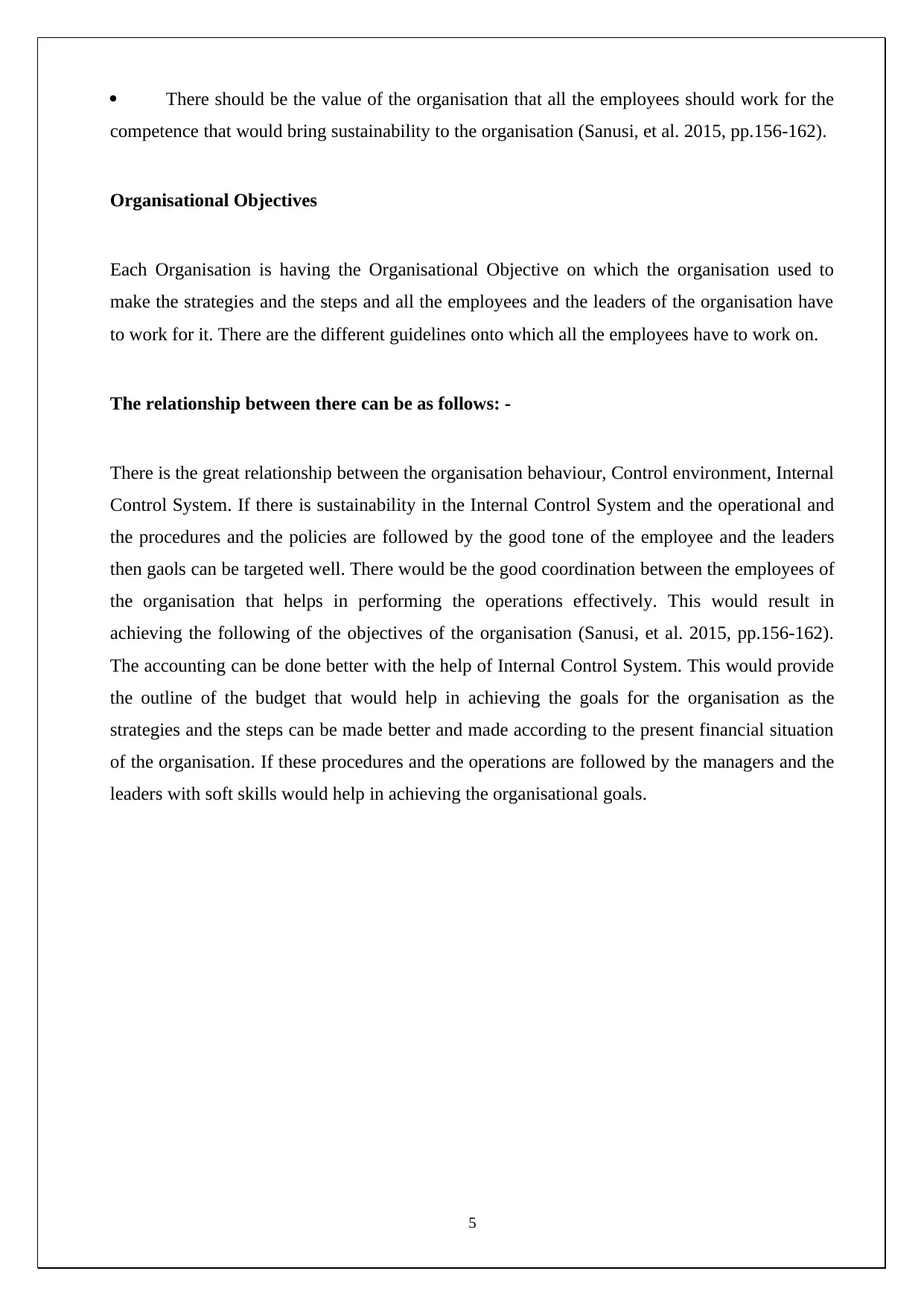
There should be the value of the organisation that all the employees should work for the
competence that would bring sustainability to the organisation (Sanusi, et al. 2015, pp.156-162).
Organisational Objectives
Each Organisation is having the Organisational Objective on which the organisation used to
make the strategies and the steps and all the employees and the leaders of the organisation have
to work for it. There are the different guidelines onto which all the employees have to work on.
The relationship between there can be as follows: -
There is the great relationship between the organisation behaviour, Control environment, Internal
Control System. If there is sustainability in the Internal Control System and the operational and
the procedures and the policies are followed by the good tone of the employee and the leaders
then gaols can be targeted well. There would be the good coordination between the employees of
the organisation that helps in performing the operations effectively. This would result in
achieving the following of the objectives of the organisation (Sanusi, et al. 2015, pp.156-162).
The accounting can be done better with the help of Internal Control System. This would provide
the outline of the budget that would help in achieving the goals for the organisation as the
strategies and the steps can be made better and made according to the present financial situation
of the organisation. If these procedures and the operations are followed by the managers and the
leaders with soft skills would help in achieving the organisational goals.
5
competence that would bring sustainability to the organisation (Sanusi, et al. 2015, pp.156-162).
Organisational Objectives
Each Organisation is having the Organisational Objective on which the organisation used to
make the strategies and the steps and all the employees and the leaders of the organisation have
to work for it. There are the different guidelines onto which all the employees have to work on.
The relationship between there can be as follows: -
There is the great relationship between the organisation behaviour, Control environment, Internal
Control System. If there is sustainability in the Internal Control System and the operational and
the procedures and the policies are followed by the good tone of the employee and the leaders
then gaols can be targeted well. There would be the good coordination between the employees of
the organisation that helps in performing the operations effectively. This would result in
achieving the following of the objectives of the organisation (Sanusi, et al. 2015, pp.156-162).
The accounting can be done better with the help of Internal Control System. This would provide
the outline of the budget that would help in achieving the goals for the organisation as the
strategies and the steps can be made better and made according to the present financial situation
of the organisation. If these procedures and the operations are followed by the managers and the
leaders with soft skills would help in achieving the organisational goals.
5
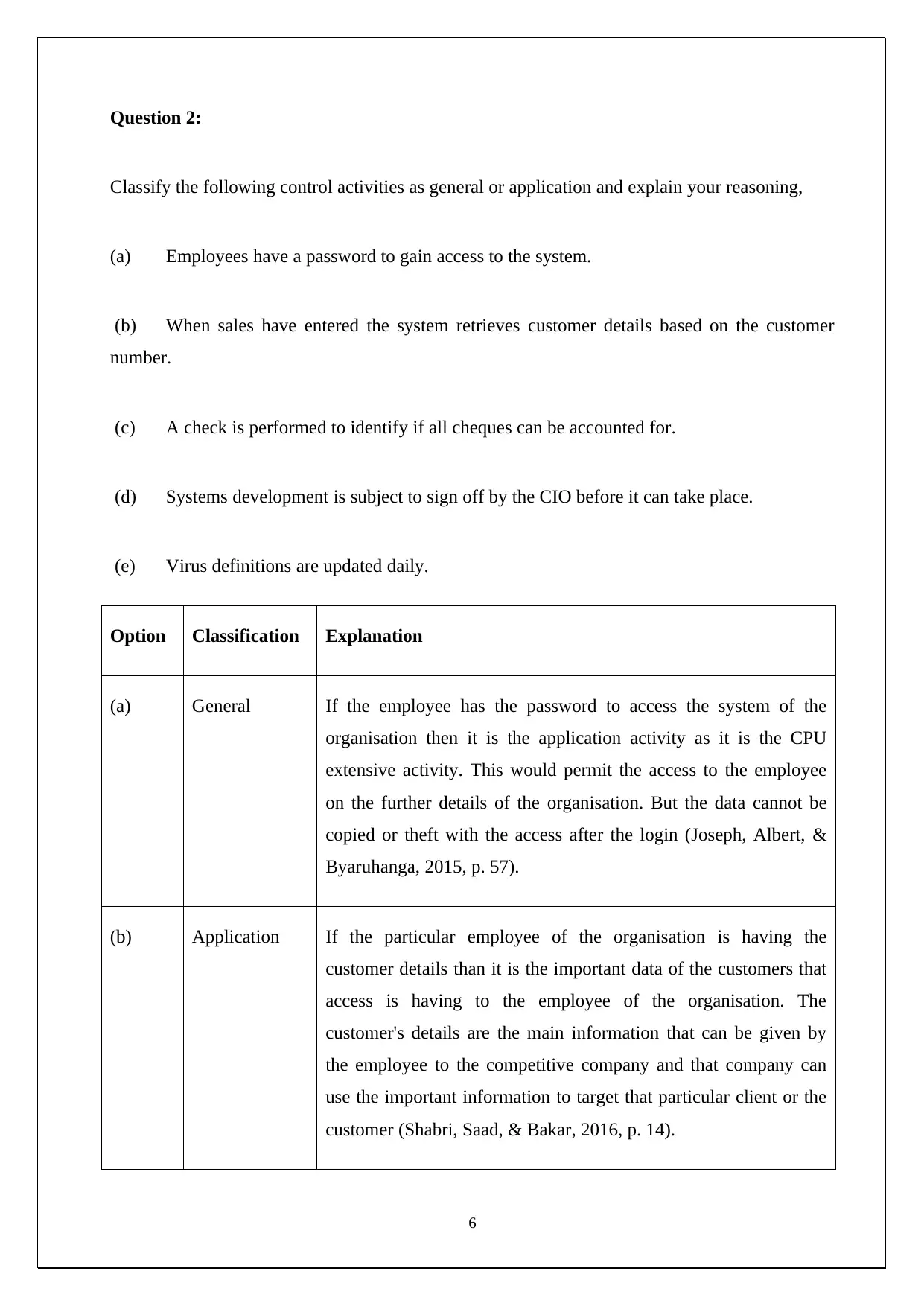
Question 2:
Classify the following control activities as general or application and explain your reasoning,
(a) Employees have a password to gain access to the system.
(b) When sales have entered the system retrieves customer details based on the customer
number.
(c) A check is performed to identify if all cheques can be accounted for.
(d) Systems development is subject to sign off by the CIO before it can take place.
(e) Virus definitions are updated daily.
Option Classification Explanation
(a) General If the employee has the password to access the system of the
organisation then it is the application activity as it is the CPU
extensive activity. This would permit the access to the employee
on the further details of the organisation. But the data cannot be
copied or theft with the access after the login (Joseph, Albert, &
Byaruhanga, 2015, p. 57).
(b) Application If the particular employee of the organisation is having the
customer details than it is the important data of the customers that
access is having to the employee of the organisation. The
customer's details are the main information that can be given by
the employee to the competitive company and that company can
use the important information to target that particular client or the
customer (Shabri, Saad, & Bakar, 2016, p. 14).
6
Classify the following control activities as general or application and explain your reasoning,
(a) Employees have a password to gain access to the system.
(b) When sales have entered the system retrieves customer details based on the customer
number.
(c) A check is performed to identify if all cheques can be accounted for.
(d) Systems development is subject to sign off by the CIO before it can take place.
(e) Virus definitions are updated daily.
Option Classification Explanation
(a) General If the employee has the password to access the system of the
organisation then it is the application activity as it is the CPU
extensive activity. This would permit the access to the employee
on the further details of the organisation. But the data cannot be
copied or theft with the access after the login (Joseph, Albert, &
Byaruhanga, 2015, p. 57).
(b) Application If the particular employee of the organisation is having the
customer details than it is the important data of the customers that
access is having to the employee of the organisation. The
customer's details are the main information that can be given by
the employee to the competitive company and that company can
use the important information to target that particular client or the
customer (Shabri, Saad, & Bakar, 2016, p. 14).
6
⊘ This is a preview!⊘
Do you want full access?
Subscribe today to unlock all pages.

Trusted by 1+ million students worldwide
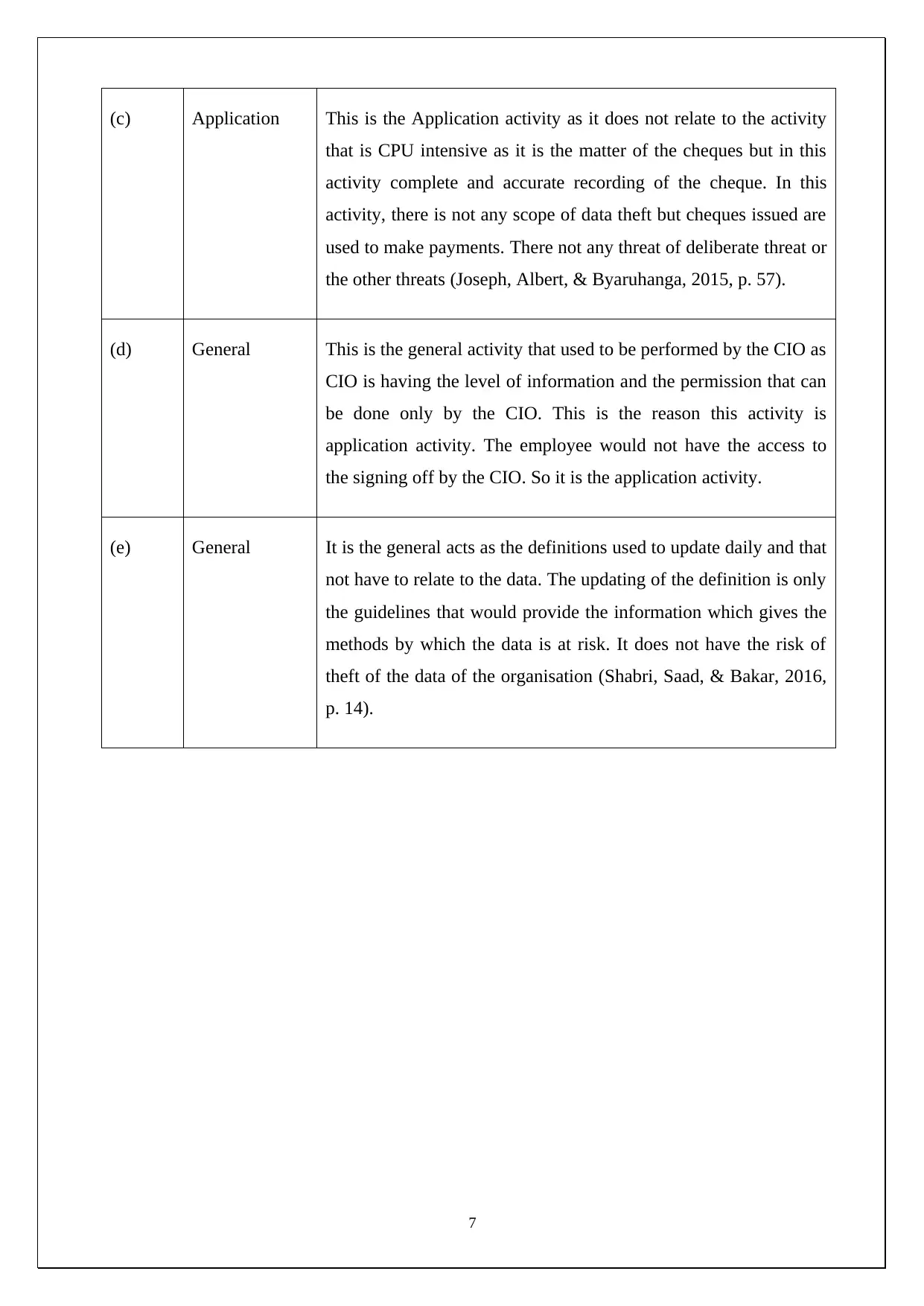
(c) Application This is the Application activity as it does not relate to the activity
that is CPU intensive as it is the matter of the cheques but in this
activity complete and accurate recording of the cheque. In this
activity, there is not any scope of data theft but cheques issued are
used to make payments. There not any threat of deliberate threat or
the other threats (Joseph, Albert, & Byaruhanga, 2015, p. 57).
(d) General This is the general activity that used to be performed by the CIO as
CIO is having the level of information and the permission that can
be done only by the CIO. This is the reason this activity is
application activity. The employee would not have the access to
the signing off by the CIO. So it is the application activity.
(e) General It is the general acts as the definitions used to update daily and that
not have to relate to the data. The updating of the definition is only
the guidelines that would provide the information which gives the
methods by which the data is at risk. It does not have the risk of
theft of the data of the organisation (Shabri, Saad, & Bakar, 2016,
p. 14).
7
that is CPU intensive as it is the matter of the cheques but in this
activity complete and accurate recording of the cheque. In this
activity, there is not any scope of data theft but cheques issued are
used to make payments. There not any threat of deliberate threat or
the other threats (Joseph, Albert, & Byaruhanga, 2015, p. 57).
(d) General This is the general activity that used to be performed by the CIO as
CIO is having the level of information and the permission that can
be done only by the CIO. This is the reason this activity is
application activity. The employee would not have the access to
the signing off by the CIO. So it is the application activity.
(e) General It is the general acts as the definitions used to update daily and that
not have to relate to the data. The updating of the definition is only
the guidelines that would provide the information which gives the
methods by which the data is at risk. It does not have the risk of
theft of the data of the organisation (Shabri, Saad, & Bakar, 2016,
p. 14).
7
Paraphrase This Document
Need a fresh take? Get an instant paraphrase of this document with our AI Paraphraser
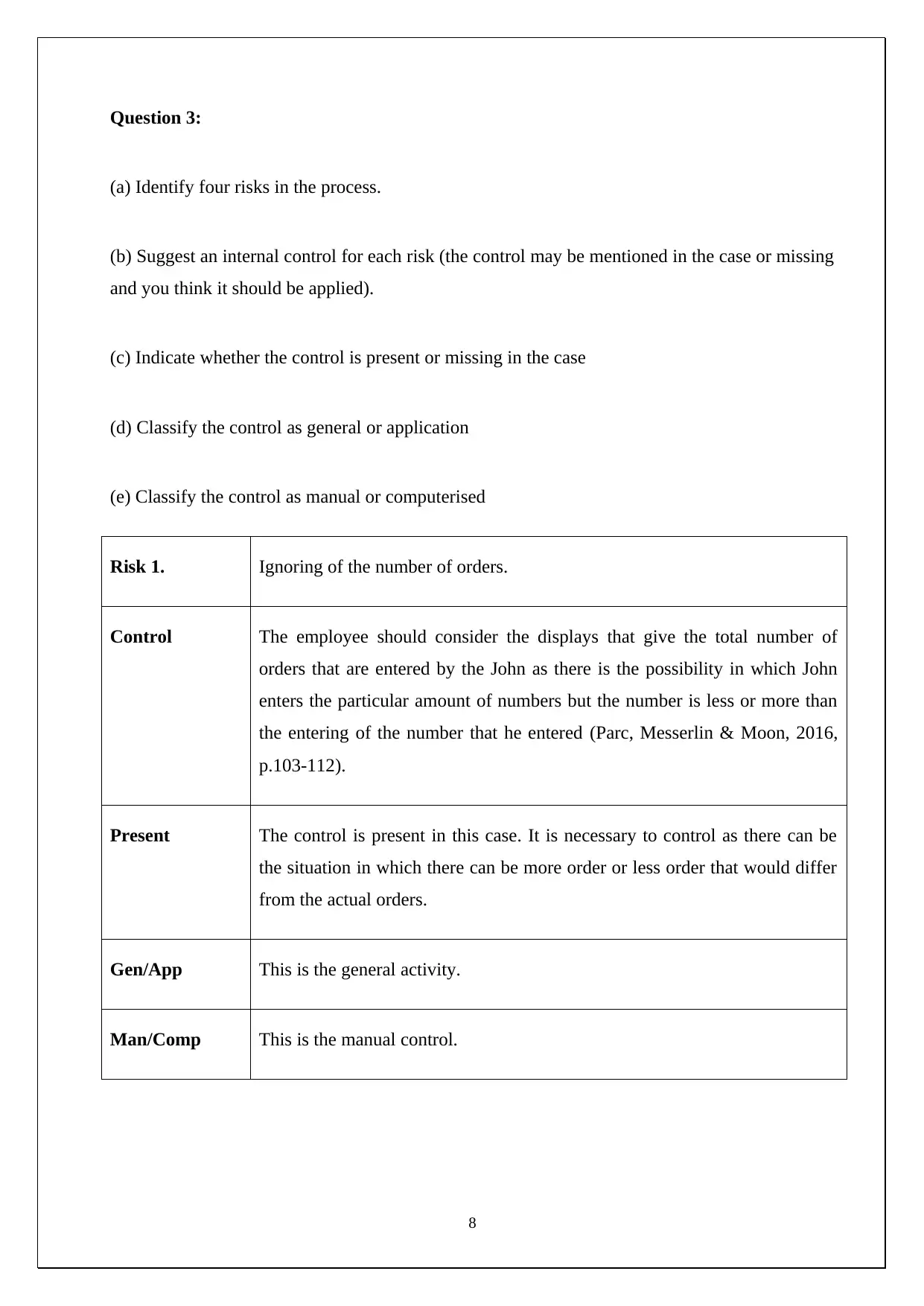
Question 3:
(a) Identify four risks in the process.
(b) Suggest an internal control for each risk (the control may be mentioned in the case or missing
and you think it should be applied).
(c) Indicate whether the control is present or missing in the case
(d) Classify the control as general or application
(e) Classify the control as manual or computerised
Risk 1. Ignoring of the number of orders.
Control The employee should consider the displays that give the total number of
orders that are entered by the John as there is the possibility in which John
enters the particular amount of numbers but the number is less or more than
the entering of the number that he entered (Parc, Messerlin & Moon, 2016,
p.103-112).
Present The control is present in this case. It is necessary to control as there can be
the situation in which there can be more order or less order that would differ
from the actual orders.
Gen/App This is the general activity.
Man/Comp This is the manual control.
8
(a) Identify four risks in the process.
(b) Suggest an internal control for each risk (the control may be mentioned in the case or missing
and you think it should be applied).
(c) Indicate whether the control is present or missing in the case
(d) Classify the control as general or application
(e) Classify the control as manual or computerised
Risk 1. Ignoring of the number of orders.
Control The employee should consider the displays that give the total number of
orders that are entered by the John as there is the possibility in which John
enters the particular amount of numbers but the number is less or more than
the entering of the number that he entered (Parc, Messerlin & Moon, 2016,
p.103-112).
Present The control is present in this case. It is necessary to control as there can be
the situation in which there can be more order or less order that would differ
from the actual orders.
Gen/App This is the general activity.
Man/Comp This is the manual control.
8
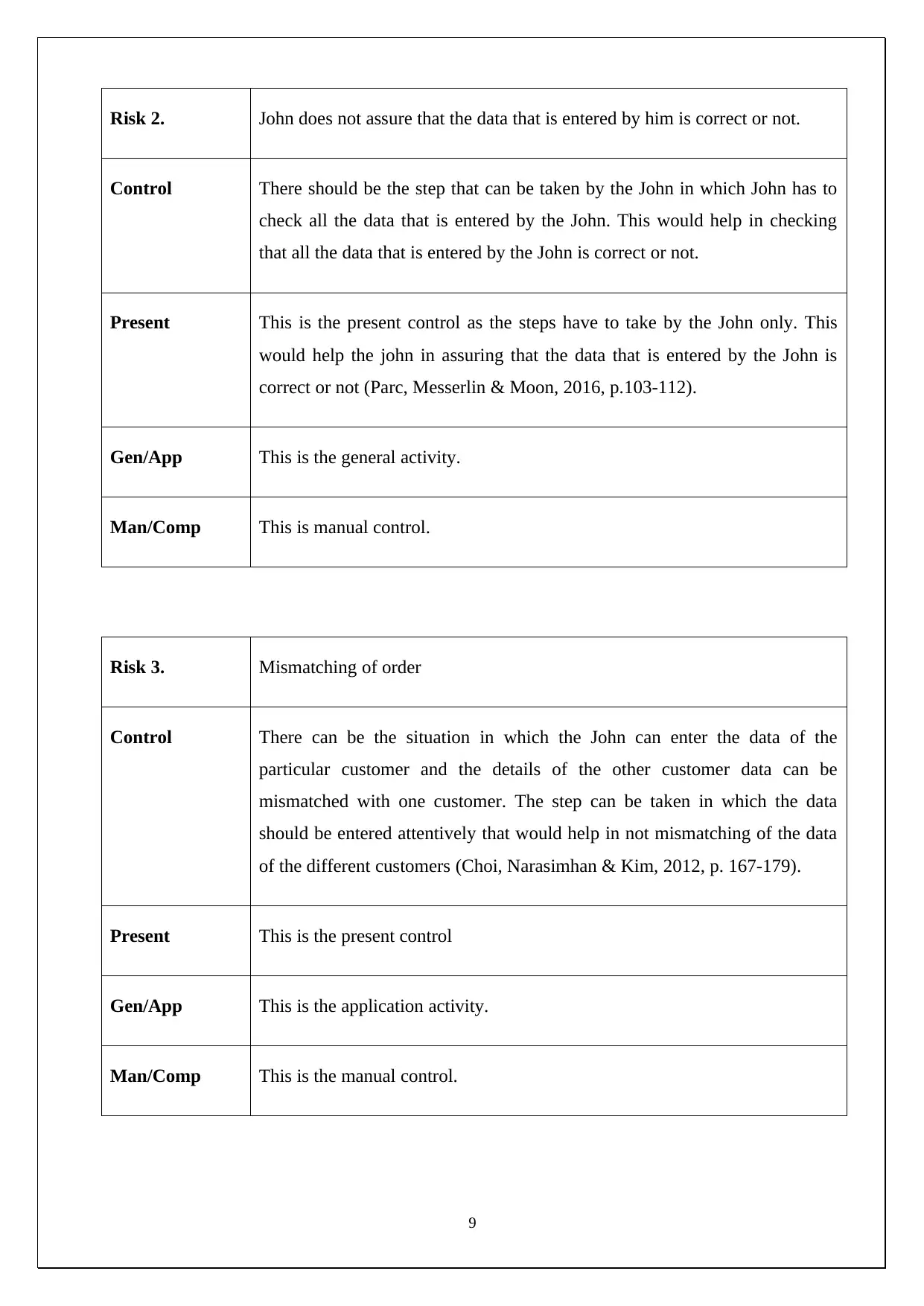
Risk 2. John does not assure that the data that is entered by him is correct or not.
Control There should be the step that can be taken by the John in which John has to
check all the data that is entered by the John. This would help in checking
that all the data that is entered by the John is correct or not.
Present This is the present control as the steps have to take by the John only. This
would help the john in assuring that the data that is entered by the John is
correct or not (Parc, Messerlin & Moon, 2016, p.103-112).
Gen/App This is the general activity.
Man/Comp This is manual control.
Risk 3. Mismatching of order
Control There can be the situation in which the John can enter the data of the
particular customer and the details of the other customer data can be
mismatched with one customer. The step can be taken in which the data
should be entered attentively that would help in not mismatching of the data
of the different customers (Choi, Narasimhan & Kim, 2012, p. 167-179).
Present This is the present control
Gen/App This is the application activity.
Man/Comp This is the manual control.
9
Control There should be the step that can be taken by the John in which John has to
check all the data that is entered by the John. This would help in checking
that all the data that is entered by the John is correct or not.
Present This is the present control as the steps have to take by the John only. This
would help the john in assuring that the data that is entered by the John is
correct or not (Parc, Messerlin & Moon, 2016, p.103-112).
Gen/App This is the general activity.
Man/Comp This is manual control.
Risk 3. Mismatching of order
Control There can be the situation in which the John can enter the data of the
particular customer and the details of the other customer data can be
mismatched with one customer. The step can be taken in which the data
should be entered attentively that would help in not mismatching of the data
of the different customers (Choi, Narasimhan & Kim, 2012, p. 167-179).
Present This is the present control
Gen/App This is the application activity.
Man/Comp This is the manual control.
9
⊘ This is a preview!⊘
Do you want full access?
Subscribe today to unlock all pages.

Trusted by 1+ million students worldwide
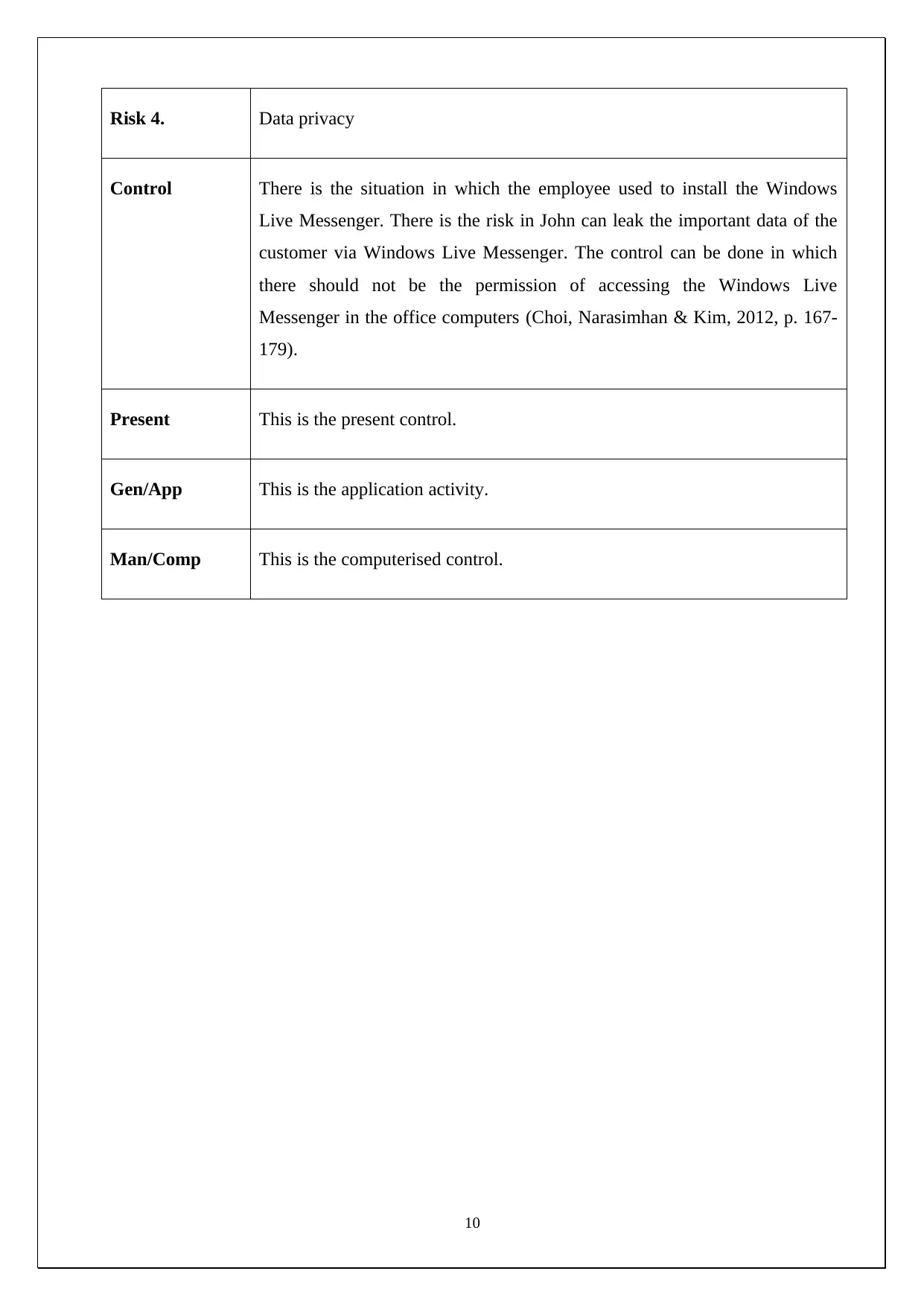
Risk 4. Data privacy
Control There is the situation in which the employee used to install the Windows
Live Messenger. There is the risk in John can leak the important data of the
customer via Windows Live Messenger. The control can be done in which
there should not be the permission of accessing the Windows Live
Messenger in the office computers (Choi, Narasimhan & Kim, 2012, p. 167-
179).
Present This is the present control.
Gen/App This is the application activity.
Man/Comp This is the computerised control.
10
Control There is the situation in which the employee used to install the Windows
Live Messenger. There is the risk in John can leak the important data of the
customer via Windows Live Messenger. The control can be done in which
there should not be the permission of accessing the Windows Live
Messenger in the office computers (Choi, Narasimhan & Kim, 2012, p. 167-
179).
Present This is the present control.
Gen/App This is the application activity.
Man/Comp This is the computerised control.
10
Paraphrase This Document
Need a fresh take? Get an instant paraphrase of this document with our AI Paraphraser

References
Choi, K, Narasimhan, R & Kim, SW 2012, ‘Postponement strategy for international
transfer of products in a global supply chain: A system dynamics examination’, Journal
of operations Management, vol. 30, no. 3, pp. 167-179.
Joseph, ON, Albert, O and Byaruhanga, J 2015, ‘Effect of Internal Control on Fraud
Detection and Prevention in District Treasuries of Kakamega County’, Int. J. Bus.
Manag. Invent, vol. 4, no. 1, pp. 47-57.
Mary, M, Albert, O and Byaruhanga, J 2014, ‘Effects of internal control systems on
financial performance of sugarcane out grower companies in Kenya’, IOSR Journal of
Business and Management, vol. 16, no. 12, pp. 2319.
Parc, J, Messerlin, P and Moon, HC 2016, ‘The Secret to the Success of K-Pop: The
Benefits of Well-Balanced Copyrights’, Corporate Espionage, Geopolitics, and
Diplomacy Issues in International Business, pp.130-148.
Sanusi, ZM, Johari, RJ, Said, J and Iskandar, T 2015, ‘The Effects of Internal Control
System, Financial Management and Accountability of NPOs: The Perspective of
Mosques in Malaysia’, Procedia Economics and Finance, 28, pp.156-162.
Shabri, SM, Saad, RAJ and Bakar, AA 2016, ‘The Effects of Internal Control Systems on
Cooperative's Profitability: A Case of Koperasi ABC Berhad’, International Review of
Management and Marketing, vol. 6, pp. 13-14.
11
Choi, K, Narasimhan, R & Kim, SW 2012, ‘Postponement strategy for international
transfer of products in a global supply chain: A system dynamics examination’, Journal
of operations Management, vol. 30, no. 3, pp. 167-179.
Joseph, ON, Albert, O and Byaruhanga, J 2015, ‘Effect of Internal Control on Fraud
Detection and Prevention in District Treasuries of Kakamega County’, Int. J. Bus.
Manag. Invent, vol. 4, no. 1, pp. 47-57.
Mary, M, Albert, O and Byaruhanga, J 2014, ‘Effects of internal control systems on
financial performance of sugarcane out grower companies in Kenya’, IOSR Journal of
Business and Management, vol. 16, no. 12, pp. 2319.
Parc, J, Messerlin, P and Moon, HC 2016, ‘The Secret to the Success of K-Pop: The
Benefits of Well-Balanced Copyrights’, Corporate Espionage, Geopolitics, and
Diplomacy Issues in International Business, pp.130-148.
Sanusi, ZM, Johari, RJ, Said, J and Iskandar, T 2015, ‘The Effects of Internal Control
System, Financial Management and Accountability of NPOs: The Perspective of
Mosques in Malaysia’, Procedia Economics and Finance, 28, pp.156-162.
Shabri, SM, Saad, RAJ and Bakar, AA 2016, ‘The Effects of Internal Control Systems on
Cooperative's Profitability: A Case of Koperasi ABC Berhad’, International Review of
Management and Marketing, vol. 6, pp. 13-14.
11
1 out of 11
Related Documents
Your All-in-One AI-Powered Toolkit for Academic Success.
+13062052269
info@desklib.com
Available 24*7 on WhatsApp / Email
![[object Object]](/_next/static/media/star-bottom.7253800d.svg)
Unlock your academic potential
Copyright © 2020–2025 A2Z Services. All Rights Reserved. Developed and managed by ZUCOL.



